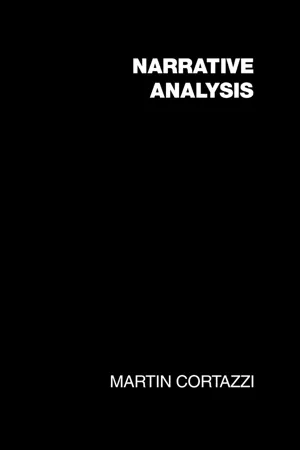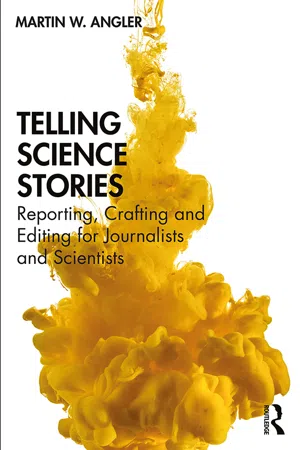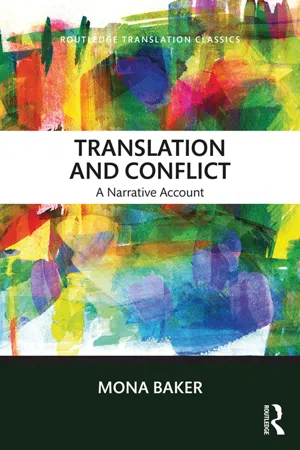Narrative Structure
Narrative structure refers to the organization and arrangement of events within a story. It encompasses the way in which a narrative is presented, including the sequence of events, the pacing, and the overall framework. This structure helps to shape the reader's experience and understanding of the story, and can vary widely across different literary works.
7 Key excerpts on "Narrative Structure"
- eBook - ePub
How to Read Like a Writer
10 Lessons to Elevate Your Reading and Writing Practice
- Erin M. Pushman(Author)
- 2021(Publication Date)
- Bloomsbury Academic(Publisher)
...A narrative that began here might also be expected to back up and tell the story of how the six-year-old found her way to the gun and later move on to the aftermath. As writers shape their work, they select or invent a structure that guides the piece through the narrative arc. Structure can range from the simple to the complex, and, like genre, can run the gamut from easy to define to not-so-easy. While we can’t discuss every structural possibility in one lesson, we can cover some common structures. Let’s remember that the following structures can be found in narratives in any genre, including hybrids. These structures can also be applied to non-narrative creative nonfiction and poetry (as we will briefly discuss later in this lesson). Liner In a linear structure, the story unfolds in one narrative arc and in a straightforward, beginning, middle, then end sort of a way. If a non-narrative essay or poem has a linear structure, the central concept will be presented in a straightforward, linear way. Many readings in this book have linear structures, including “Sea Urchin,” “What You Learn in College,” “Grace,” “Cartography,” “They Point at Her Face and Whisper,” “Negative Results,” “The Embassy of Cambodia,” “Hestur: A Photo Essay,” and The Contradictions. Others, like “Jerry’s Crab Shack: One Star,” take a linear structure even as they also borrow another. Notice how these readings represent each genre. Linear structures are also often chronological, in that they follow the order of events happening in time. However, some narratives with linear structures unfold in one narrative arc but are not necessarily organized around the order of events happening in time. “They Point at Her Face and Whisper” is one example from the Readings. While chronology is present, the blog post come essay is not married to chronology. Instead, it is guided by a central theme presented in a linear way throughout the narrative...
- eBook - ePub
- Martin Cortazzi(Author)
- 2014(Publication Date)
- Routledge(Publisher)
...Chapter 5 Literary Models of Narrative Introduction Within literary theory there is no universally accepted model of narrative, although since the 1970s the theory of narrative has become a central topic in literary study. The continuous shift in the meaning understood by the term ‘narrative’ in the history of literature, and subsequent description of this, itself illustrates an important point: the tendency for critics and theorists to look for an orderly development of narrative works and narrative theory is evidence of how people use narratives to impose patterns on the past in order to tell a coherent story about it (Martin, 1986). In this way it is suggested that narrative models in literature have developed from Russian formalism through French structuralism towards post-structuralist and reader-oriented theories (Eagleton, 1983; Martin, 1986). Other important recent branches of narrative study include Marxist, feminist and psychoanalytic views. In the following sections attention will be given to selected concepts of narrative. These are definitions of narrative, views of structural narratology, and some particular aspects of narration including tense, mood and voice. These concepts are derived mainly from structuralist views which attempt to apply by analogy models of sentence grammar from linguistics to literary discourse. There is an obvious major limitation in transferring insights from literary theory to an analysis of oral narratives of personal experience. Literary theory has primarily focussed on novels and short stories. It is expected that there will be far greater complexity, artistry and imagination in such written works, compared with the spontaneous, oral non-fictional narratives of personal experience...
- eBook - ePub
- Monika Fludernik(Author)
- 2009(Publication Date)
- Routledge(Publisher)
...The majority of chapter breaks are pragmatically motivated: they divide long stretches of narrative into more easily digestible morsels. Some authors, especially nineteenth-century ones, are particularly adept at chapter management. As a result of the serial publication of their works in periodicals, writers such as Charles Dickens were obliged always to end their instalments on a note of suspense, develop each and every strand of the plot in each episode and structure each instalment quite unmistakably as a sequence of three to four chapters. Structuring elements resembling chapters are also to be found within films, and not only in early productions which actually signalled a change of scene by means of written messages to the audience (‘Ten years later’ or ‘Meanwhile, back at the ranch’). To the best of my knowledge, this aspect has been somewhat neglected in film studies. In the meantime, a similar kind of structuring is quite clearly noticeable in films made for television because these have to take commercial breaks into account, the element of suspense clearly playing an important part in deciding where and when the breaks are to occur. With DVDs, moreover, films are divided into scene sequences and in some cases these are given individual titles. In theatre performances, visual markers (curtain, music, shifting of props) indicate scene and act changes. (But not always: in plays with multi-scene acts, the interval or intervals will tend to superimpose their structure on the five acts.) Text–internal Narrative Structures Narrative levels To begin with, a distinction has to be made between various levels of narrative. Thus, in accordance with the well-known communicative model of narrative (A. Nünning 1989, Coste 1989, Sell 2000), there is a level at which the narrator (that is to say a narrator who is constituted in the text) communicates with a narratee. This level of narration or narrative communication can be either implicit or explicit...
- eBook - ePub
Telling Science Stories
Reporting, Crafting and Editing for Journalists and Scientists
- Martin W. Angler(Author)
- 2020(Publication Date)
- Routledge(Publisher)
...Indeed, most representations of story structures manifest as two-dimensional line graphs of sorts, where one axis is time and the other one is tension or action (like Freytag’s and Hart’s). The planner then distributes plot points on that axis. That’s it. Plotting and outlining is all about selection and ordering. And rejection. Investigations practically never result in short pieces. In his book Story-based Inquiry (freely available, just Google it), investigative journalist Mark Lee Hunter details how to come up with an appropriate narrative at the end of an extensive investigative journalism project. You can structure your narrative in two ways. First, use a picaresque structure to order events by place, with the characters moving across those places over time. Homer’s Odyssey is an example of this structure. On a more contemporary note, Michael Moore tends to use that sort of structure in his documentaries (Hunter 2011). I can’t help but think of James Bond movies when I read about this structure. Hunter doesn’t really draw his structures as story shapes. If he did, he’d have probably a third axis: tension, time (the regulars) and place. Hunter’s second type of narrative sounds familiar: it’s the chronological structure, which you should use when ordering your events by time. Ultimately, it’s the material you gathered during the reporting that will determine which structure is the best for your story, but “one of these forms is right for your story” (Hunter 2011:66). Here is a short recipe on how to structure narratives. Begin with a moment that hooks the audience. Start in the present, go back in time to show how we got there (past), then bring it all the way back to the present moment (this will allow the readers to absorb the story), and then say where the story is headed to next (the future). As for chronological stories, Hunter advises to not continuously hop back and forward in time, as this confuses the readers...
- eBook - ePub
Researching Interpretive Talk Around Literary Narrative Texts
Shared Novel Reading
- John Gordon(Author)
- 2020(Publication Date)
- Routledge(Publisher)
...Narrative provides a lens by which insight may be gained. Narrative analysis is inherently interdisciplinary, given its origins in literary and cultural theory, and consequently attends to the detail of texts no matter what their medium of presentation. Since the late twentieth century the adoption of narrative analysis in social science has been concurrent with the growing popularity of qualitative methods attentive ‘to language, to the biographical, to the unconscious, to participant-centred research, to ecological research, to the social (in psychology), to the visual (in sociology and anthropology), to power, to culture, to reflexivity’ (Squire, 2008, p.6). The narrative turn refracts each of these. If narrative analysis is this versatile, having relevance across disciplines, it can also turn in on itself, to examine the place of given narratives embedded in further narration – and across the modalities of print and speech that characterise literary study classrooms. The researcher adopting methods of narrative analysis can legitimately attend to textual structures, content, performance and contexts simultaneously. In such an endeavour, the education researcher of literary study will find the syntactic/ structural models of narratology useful for considering the nature of the study text as it is experienced in print. They will also be helped by pragmatic theories of narration as performance, such as the experience-centred approaches to narrative (Mishler, 1986) used extensively in other strands of contemporary social science research. These are interested in the experiences of both speakers of tales and their audiences but surprisingly have had limited take-up in education research, even though narration is a core activity in pedagogy across phases and subjects, whether or not, obviously, narrative forms such as literary fiction are central to the immediate teaching purpose...
- eBook - ePub
Translation and Conflict
A narrative account
- Mona Baker(Author)
- 2018(Publication Date)
- Routledge(Publisher)
...Like most scholars in linguistics and pragmatics, having defined narrative as only one way of recapitulating experience, Labov goes on to focus on oral narratives and on their structural make-up. He elaborates a structural framework that divides these orally delivered stories into six components: abstract, orientation, complicating action, evaluation, result or resolution, and coda (1972: 362ff.). The components are all assumed to be realized in the form of clauses. For example, the abstract occurs at the beginning of the narration and consists of ‘one or two clauses summarizing the whole story’ (1972: 363); the orientation can occur ‘in the course of the first several narrative clauses, but more commonly there is an orientation section composed of free clauses’ (1972: 364); and so on. In its exclusive attention to oral narratives, its treatment of narrative as an optional mode of communication, and its preoccupation with the structural make-up of stories, this approach is very different from the one I intend to adopt in this book and which I attempt to elaborate in some detail in this chapter. Narration is the context for interpreting and assessing all communication – not a mode of discourse laid on by a creator’s deliberate choice but the shape of knowledge as we first apprehend it. (Fisher 1987: 193) In social and communication theory, as well as in the work of some historians such as Hayden White, narrative tends on the whole to be treated as the principal and inescapable mode by which we experience the world. Thus, Somers argues that ‘it is through narrativity that we come to know, understand, and make sense of the social world, and it is through narratives and narrativity that we constitute our social identities’ (1992: 600)...
- eBook - ePub
- David Herman(Author)
- 2011(Publication Date)
- Wiley-Blackwell(Publisher)
...J. Greimas) conceived of as a science of narrative modeled after the “pilot-science” of Ferdinand de Saussure’s structural linguistics. 1 As I discuss in greater detail below, the structuralists drew not only on Saussure’s ideas but also on the work of Russian Formalist literary theorists, who studied prose narratives of all sorts, from Tolstoi’s historically panoramic novels to tightly plotted detective novels to (Russian) fairy tales. This broad investigative focus helped initiate the narrative turn, uncoupling theories of narrative from theories of the novel, and shifting scholarly attention from a particular genre of literary writing to all discourse (or, in an even wider interpretation, all semiotic activities) that can be interpreted as narratively organized. That same shift helps explain why the present volume is titled Basic Elements of Narrative rather than Basic Elements of the Novel – even though I use narrative fiction as a key source of illustrative examples, written fictional texts being a highly developed form of storytelling across the world’s literatures. Taking their cue from the Formalists, and noting that stories can be presented in a wide variety of textual formats, media, and genres, structuralists such as Barthes ([1957] 1972, [1966] 1977) argued explicitly for an integrative approach to the analysis of narrative – an approach in which stories can be viewed as supporting many cognitive and communicative activities, from spontaneous conversations and historiographic writing to visual art, dance, and mythic and literary traditions. Only after the heyday of structuralism, however, did such an approach to narrative begin to emerge. Although more needs to be done to promote genuine dialogue and exchange among story analysts working in different fields (Hyvärinen 2006), it is undeniable that the past decade in particular has seen an exponential growth of cross-disciplinary research and teaching activity centering around narrative...






